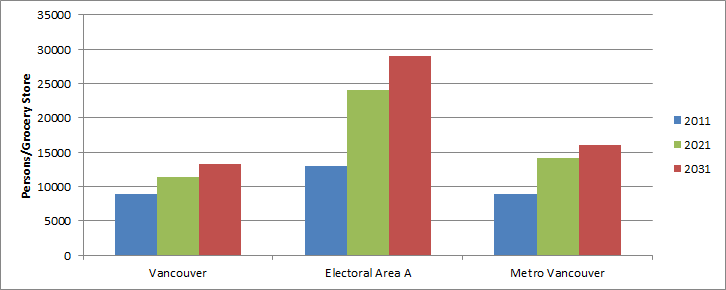A new grocery store opened up recently in the New SUB. That’s great news, because UBC is a food desert!
What’s meant by a food desert? Here’s a quick experiment. Count up the mid-size and large grocery retailers in the lower mainland and sort them by municipality*. Then, compare that with Metro Vancouver’s current and future population figures. This is the resulting bar graph.
Yeah, that’s a lot of bars without any clear meaning. But it should be clear that Electoral Area A (which includes UBC and the UEL) on the right end is an outlier on that graph. For simplicity’s sake, let’s zoom in and compare just Vancouver, Electoral Area A, and Metro Vancouver as a whole.
From both charts, it’s clear that within five years, Electoral Area A will have the least grocery stores per capita in the lower mainland. Continued development over time will exacerbate the problem. More concerning, the lack of grocery stores at UBC is probably even worse than that graph lets on for a few reasons.
Firstly, the population estimates for Electoral Area A systematically undercount the number of actual humans on campus quite significantly. UBC has decided to arbitrarily exclude all students living on campus from population estimates, meaning that there are thousands of actual humans living on campus who need to buy groceries and eat food but who are not captured in the population numbers used to make the charts. No other jurisdiction arbitrarily excludes students from their population numbers.
Secondly, while the graph only includes mid- to full size grocery options, typical neighbourhoods in the lower mainland have a variety of other stores where food is available: produce stores, ethnic grocers, bakeries, butchers, fish mongers, etc. The grocery store in the New SUB has not been included here – it is so small that its scale makes it more like an ethnic grocer rather than a proper grocery store. Alternatives to Save On in Electoral Area A are almost non-existent in comparison to the variety available elsewhere.**
Thirdly, the above graphs assume that no new grocery stores will be built in the future – a bad assumption, unless you’re at UBC. In other jurisdictions it would be natural to expect that new commercial developments will be built to keep up with population growth and therefore the number of residents per grocery store may actually stay relatively stable over time in Vancouver and in the region as a whole. But in Electoral Area A, UBC Properties Trust has informally said in the past that they do not intend to offer any single retail space in the future larger than 10,000 sq. feet, and have no plans for an additional grocery store beyond Save On Foods.***
For all the planner-babble about sustainable, mixed use, compact communities, there does not yet seem to be a recognition of the crazy fact that people living on campus need to eat. UBC can’t just keep building housing and parks and expect all of the other aspects of a community to take care of themselves. Michelle Paquet, a Development Manager with UBC Properties Trust, said at a Development Permit Board meeting earlier this year that for a mixed-use commercial centre to be successful, it needs three anchor tenants: a grocery store, a liquor store, and a pharmacy. In Wesbrook Place they have the first two and are courting a pharmacy to open up shop so that it will have all three. But in other areas, (including U-Boulevard and Acadia Park), UBC isn’t trying to build a functional community; they’re just building places for people to live.
Notes:
* “North Vancouver” includes both City of North Vancouver City and District of North Vancouver; “Langley” includes both City of Langley and Township of Langley because I was too lazy to figure out the EXACT locations of every single store.
**It’s also possible to count the very limited selections of groceries available at residence convenience stores and Shoppers Drug Mart, but then it’s also necessary to take into account how many of those types of stores can be found in other neighbourhoods in comparison – still likely fewer on campus.
***The Musqueam have mused about a small “community grocery store” (think Nester’s Market) as a possibility for their Block F development. That’s great, but I think UBC can do way better than that. Put a No Frills on the corner of University Boulevard and Wesbrook. Or better yet, do something innovative like this no packaging grocery store. Seriously.








Discussion
Comments are disallowed for this post.
Comments are closed.